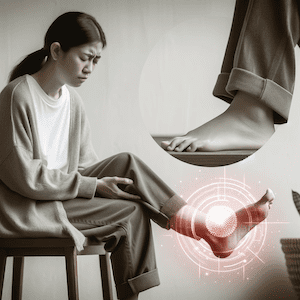Ballet Injuries
Article by Nadine Stewart

Ballet Injuries
Optimising Ballet Performance: A Physiotherapist’s Guide to Injury Prevention and Management
Introduction
Ballet is not just an art form but also a physically demanding sport that combines grace with strength and agility. While the allure of ballet is undeniable, it also brings a risk of injury, which can hinder performance and progress. As physiotherapists, we specialise in understanding and managing ballet-related injuries, offering strategies for both prevention and rehabilitation.

What is the Most Common Injury in Ballet?
The most common injuries in ballet dancers often involve the lower extremities, reflecting the physical demands of ballet on the body.
Ankle Sprains
Ankle sprains are particularly frequent due to the stress placed on the ankles by jumping, turning, and dancing en pointe. This type of injury occurs when the ligaments that support the ankle stretch beyond their limits or tear, leading to pain, swelling, and difficulty bearing weight on the affected limb.
In addition to ankle sprains, dancers frequently experience injuries to their feet, hips, and back.
Dancer’s Fracture
Stress fractures in the feet, known as “dancer’s fracture,” result from repetitive impact and can cause significant pain and mobility issues.
Hip Labral Tears
The hips are susceptible to labral tears and snapping hip syndrome due to the extensive range of motion required in ballet.
Dancer’s Back Injuries
Back injuries, particularly stress fractures in the vertebrae (spondylolysis), occur from repetitive extension and flexion movements.
Managing Ballet Injuries
Ballet dancers are athletes in their own right, enduring rigorous training that can lead to various injuries. The most common injuries include tendinopathies, sprains, and strains, affecting areas such as the back, hips, knees, legs, ankles, and feet. Understanding these injuries is the first step towards effective management and prevention.
Preventing Overuse Injuries in Ballet
Overuse injuries are common in ballet due to repetitive movements and intense training schedules. These injuries develop gradually and can become severe if not addressed timely. Prevention strategies involve proper technique, balanced training routines, and addressing any muscle imbalances or biomechanical issues.
Prevention strategies for these injuries include maintaining proper technique, ensuring adequate warm-up and cool-down, utilising cross-training to build strength and flexibility, and paying attention to nutrition for muscle and bone health. Proper footwear and attention to body alignment during dance movements are also critical for minimising the risk of injury.
For further detailed prevention tips and injury management strategies, consulting a physiotherapist familiar with ballet can provide tailored advice and support. Ballet dancers, like all athletes, benefit from a holistic approach to their training and health to stay injury-free and perform at their best.
Navigating Acute Ballet Injuries
Acute injuries, though less common, occur suddenly and are often the result of a specific incident, such as a fall or misstep. These injuries require immediate attention and appropriate treatment to ensure a quick and safe return to dance.
What Percentage of Ballet Dancers Get Injured?
Ballet dancers often face a high risk of injury due to the physically demanding nature of their art. Studies suggest that between 67% to 95% of ballet dancers experience at least one injury per year that affects their ability to perform. This wide range is due to various factors, including the intensity of training, the level of professional or amateur status, and individual health conditions.
Injuries are common in both the lower and upper body, with ankle sprains, stress fractures, and muscle strains being particularly prevalent. The repetitive nature of ballet movements, combined with the need for dancers to push their bodies to the limit, contributes significantly to this high injury rate. As a result, injury prevention and management are crucial aspects of a dancer’s training regime.
Ballet Injury Risk Factors
Several factors contribute to the risk of injury in ballet, including age, gender, training load, previous injuries, and individual anatomical differences. Recognising these factors helps in tailoring preventive strategies and treatments for each dancer.
Injury Prevention Strategies
Injury prevention in ballet revolves around strengthening, flexibility, control, and balance. Warm-ups and cool-downs are essential to prepare the body for the demands of ballet. Additionally, proper footwear and attention to technique are crucial in reducing injury risk.
Physiotherapy for Ballet Dancers
Physiotherapy plays a vital role in both preventing and treating ballet injuries. A physiotherapist can provide personalised advice, conduct dance screenings, and design injury prevention programs. They can also assist in improving technique and addressing specific physical limitations.
Returning to Ballet Post-Injury
Recovery and rehabilitation are critical for a safe return to ballet post-injury. This process may involve a combination of rest, specific exercises, and physiotherapy techniques. It’s important to follow a structured plan to prevent re-injury and ensure a full recovery.
What to Do? Consulting Your Physiotherapist
If you’re a ballet dancer dealing with an injury or looking to prevent one, consulting a physiotherapist is a wise step. They can provide you with tailored advice and strategies based on your specific needs and goals.
Conclusion
Injury prevention and effective management are key to a long and successful career in ballet. Physiotherapy offers invaluable insights and strategies in this regard, ensuring dancers can perform at their best while minimising the risk of injury.
Related Articles
- Ankle Sprain Management and Prevention
Discover strategies to manage and prevent ankle sprains, a common issue for ballet dancers. - Foot Care for Dancers
Learn about the importance of foot care and injury prevention for dancers. - Hip Injuries in Dancers: Prevention and Treatment
This page provides insights into common hip injuries among dancers and how to prevent them. - Back Care for Dancers
Explore techniques to strengthen and protect the back, reducing the risk of injuries for ballet dancers. - Stress Fracture Prevention in Ballet Dancers
Find out how ballet dancers can prevent stress fractures, with a focus on foot health and injury avoidance. - Pre-Pointe Assessment for Ballet Dancers
Understand the importance of a pre-pointe assessment to ensure readiness for pointe work and prevent injuries. - Dance Screening for Injury Prevention
Learn how dance screenings can identify potential injury risks and help in creating personalised prevention strategies. - Nutrition and Bone Health for Dancers
Information on how proper nutrition supports bone health, crucial for preventing fractures and other injuries in ballet. - Cross-Training for Ballet Dancers
Discover the benefits of cross-training in building strength and flexibility, reducing the risk of overuse injuries. - Physiotherapy Techniques for Ballet Injury Rehabilitation
Get an overview of various physiotherapy techniques used in the rehabilitation of common ballet injuries.
Rochedale - Call 38410277
Book Online: RochedaleSalisbury - Call 32751044
Book Online: SalisburySandgate - Call 32691122
Book Online: SandgateCommon Muscle Injuries
A Physiotherapist's Guide
Introduction
Muscle injuries, presenting as muscle strain, pain or myalgia, are prevalent health issues affecting a wide range of individuals. This detailed guide, from a physiotherapist's perspective, delves into various muscle injuries, elaborating on their management, prevention, and the importance of professional advice. Explore the linked articles for an in-depth understanding of muscle injuries and their effective treatment.
Neck & Back Muscle Injuries: Causes and Solutions
- Back Muscle Pain: This pain often results from prolonged poor posture or physical overuse. Key to relief is engaging in exercises that strengthen the core muscles and improve posture, thereby alleviating the strain on the back.
- Neck Sprain: Caused by sudden, awkward movements, a neck sprain can benefit from a combination of gentle stretches and targeted strengthening exercises to restore flexibility and strength.
- Text Neck: A modern ailment resulting from extended mobile device use, text neck can lead to chronic pain. Regular breaks, posture-awareness, and neck-strengthening exercises are essential for prevention.
- Whiplash: Commonly occurring in car accidents, whiplash requires a careful approach including neck stabilisation exercises and controlled movement to encourage healing and prevent further injury.
Lower Limb Muscle Injuries: Understanding and Treating
- Hamstring Strain: Particularly common among athletes, particularly runners, this strain demands rest initially, followed by a carefully structured rehabilitation program focusing on gradual strength building and flexibility.
- Thigh Strain: Often seen in sports involving sprinting and jumping, thigh strains need a combination of rest, ice, compression, and elevation (RICE) in the initial stages, followed by carefully planned strengthening exercises.
- Groin Strain: This injury requires a nuanced approach, including sufficient rest and targeted exercises, to ensure a safe and effective recovery.
- Calf Muscle Tear: Key to recovery is a balance of rest, gentle stretching exercises, and a gradual return to full activity, ensuring the muscle heals correctly and strength is regained.
Upper Limb Muscle Injuries: Prevention and Care
- Golfer's Elbow and Tennis Elbow: Both these conditions involve inflammation of the tendons and require a rest period, followed by ice therapy and specific exercises tailored to strengthen the affected muscles.
- Corked Thigh: Resulting from direct impacts, these injuries demand immediate application of ice and a controlled, gradual exercise regime for recovery.
- DOMS, Fatigue-Related Cramps & Myalgia: Adequate rest, good hydration, and gentle stretching are crucial in alleviating these conditions.
- RSI: Regular stretching, ergonomic workplace adjustments, and taking breaks are key preventive measures for repetitive strain injury.
Systemic Causes of Muscle Pain: A Holistic View
- Fibromyalgia: This complex condition demands a holistic treatment approach, including exercise routines, stress management techniques, and sometimes medication.
- Rheumatoid Arthritis: Effective management combines medication, gentle exercise, and regular physiotherapy sessions.
Prevention and Management Strategies
- Regular Exercise: Regular physical activity helps maintain muscle strength and flexibility, reducing the risk of muscle injuries.
- Posture Improvement: Good posture, both in motion and at rest, is crucial for preventing muscle strain.
- Proper Warm-up and Cool-down: Adequate warm-up before and cool-down after physical activity is vital in preventing muscle strains and injuries.
- Ergonomic Adjustments: Making ergonomic adjustments at work and during daily activities can significantly reduce the risk of repetitive strain injuries and other muscle-related issues.
- Maintaining a Healthy Weight: Keeping a healthy weight reduces the strain on muscles, particularly in weight-bearing joints.
What to Do? Seeking Professional Advice
Consult a physiotherapist or doctor for personalised advice and treatment plans. Remember, early intervention can significantly improve recovery outcomes and prevent chronic problems.
Conclusion
While muscle injuries are common, effective management and prevention are achievable with the right approach and knowledge. Understanding the causes, symptoms, and various treatments available empowers individuals to take proactive steps in their recovery and prevention. For the most tailored and effective treatment, always seek the guidance of a professional physiotherapist.
Rochedale - Call 38410277
Book Online: RochedaleSalisbury - Call 32751044
Book Online: SalisburySandgate - Call 32691122
Book Online: SandgateCommon Ligament Injuries


Ligament Injury
Ligament injuries frequently occur in various body parts, leading to pain and restricted movement. The most common sites include the knee, ankle, shoulder, wrist, hand, and spine.
Notably, knee injuries like ACL, PCL, MCL, and LCL sprains are prevalent.
Shoulder injuries often involve the AC joint, while wrist and hand issues can include thumb and finger sprains.
Spinal ligament injuries, such as back and neck sprains, and whiplash, are also significant. Understanding these injuries helps in prevention, early detection, and effective treatment.
- Ankle Ligament Injuries
- Knee Ligament Injuries
- Shoulder Ligament Injuries
- Wrist & Hand Ligament Injuries
- Spinal Ligament Injuries
Ankle Ligament Injuries
Ankle injuries often result from sudden twists or rolls, leading to sprains and strains.
Knee Ligament Injuries
Knee ligament injuries are among the most common and can severely impact mobility and quality of life.
- ACL Injury
- PCL Injury
- MCL Sprain
- LCL Sprain
- Posterolateral Corner Injury
- Patella Dislocation
- Superior Tibiofibular Joint Sprain
Shoulder Ligament Injuries
Shoulder ligament injuries can be debilitating, affecting a range of movements.
Wrist & Hand Ligament Injuries
Injuries in the wrist and hand are common, especially in sports and physical activities.
Spinal Ligament Injuries
Spinal ligament injuries can result from various causes, including posture issues and physical impacts.
Related Articles
- Ligament Tear - Common Ligament Injuries: Offers a comprehensive overview of ligament injuries across different body parts, including prevention, early detection, and effective treatment strategies.
- Knee Ligament Injury - A Physiotherapist's Guide & Tips: Provides insights into diagnosing knee pain, covering ligament issues among other concerns, and suggests pain relief methods through exercise and treatment.
- Common Ankle Ligament Injuries: A Physiotherapist's Guide: Discusses the treatment and prevention strategies for ankle ligament injuries, emphasising the importance of early intervention.
- Sprained Ankle Treatment & Recovery Guide: Offers detailed guidance on the recovery timelines for sprained ankles, highlighting the importance of restoring strength, motion, and function for a full recovery.
- Ankle Strapping: Complete Guide To Injury Prevention: Focuses on preventing ankle injuries through effective strapping techniques and discusses conditions like ankle arthritis and biomechanical issues.
- Sub-Acute Soft Tissue Injury: Explores the treatment and recovery process for various ligament injuries, including those affecting the knee, shoulder, wrist, hand, and spine.
- Sprained Thumb Treatment And Recovery Tips: Delivers practical tips for treating and recovering from a sprained thumb, along with general management strategies for wrist and hand pain.






































































